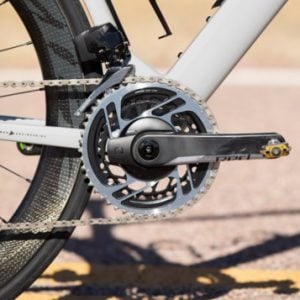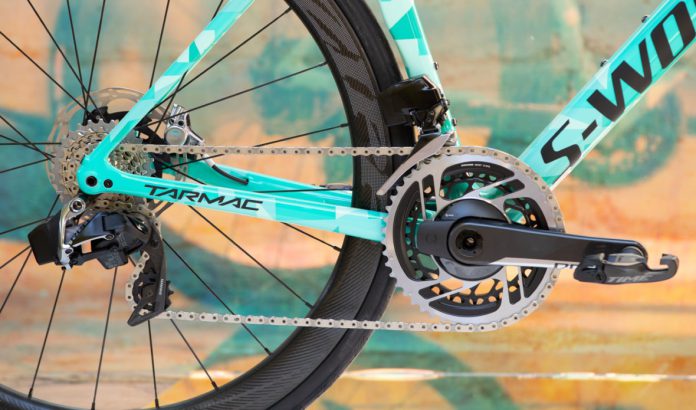You’re probably here because you’re either buying a new bike, or looking for an upgrade. In either case, if you’re making the shift to electronic gears then you’ll want to know which is most suitable for you. As they draw closer and closer, it can be hard to know exactly which to go for. It’s a tricky decision. Though if you have to choose between SRAM Red eTap AXS and Shimano Dura-Ace Di2, you’re probably not in a bad situation.
 It’s important to remember that Shimano also do the Ultegra Di2 group set, which is by far the best value for your money.
It’s important to remember that Shimano also do the Ultegra Di2 group set, which is by far the best value for your money.
— WHY YOU NEED A NEW BIKE FIT —
So why are you changing to electric in the first place? Precision shifting, light weight and being able to rely on the change as and when you need it. Mixed with being able to set up the shifters however you want, we can certainly see the appeal. And we’re big fans. The ability to have shifters in two places is also a great bonus if you’re on a TT bike.
Weight:
 Originally, SRAM Red’s complete wireless set up made it the lightest groups on the market. But the new features tip the scales marginally higher than it’s Shimano equivalent. The Shimano Dura-Ace weight in at 2389g whereas the SRAM Red groups is now 2518g.
Originally, SRAM Red’s complete wireless set up made it the lightest groups on the market. But the new features tip the scales marginally higher than it’s Shimano equivalent. The Shimano Dura-Ace weight in at 2389g whereas the SRAM Red groups is now 2518g.
Construction:
The new SRAM Red system is machined out of a single piece of metal. They’re then mounted to the crank arm using a spline, whereas the Shimano system is still bolted together and has a hollow crank arm to keep weight minimal. In theory, this makes the SRAM system a lot stiffer than the Shimano system. Though with the amount of power Peter Sagan puts through his Shimano rings, we’re fairly sure it’s stiff enough for the cycling world.
— SRAM COMPANY – WHAT YOU NEED TO KNOW —
 The unique new flat top chain system allows you to change gears smoother despite the smaller differences. It also offers the same efficiency and stops you wearing through numerous chains. SRAM claim the new flat top chain on SRAM’s Red eTAP AXS lasts an astonishing 36% longer than their 11-speed version.
The unique new flat top chain system allows you to change gears smoother despite the smaller differences. It also offers the same efficiency and stops you wearing through numerous chains. SRAM claim the new flat top chain on SRAM’s Red eTAP AXS lasts an astonishing 36% longer than their 11-speed version.
SRAM worked out early doors that to offer a much wider gear range with smaller steps, the chain would have to get narrower. The engineers worked tirelessly to find the solution – flat top. Added material on the flat side of the chain strengthens ever link. A Hard Chrome surface is a new treatment that offers the pins, inner plates and rollers extended life, and gives you the pin point shifting you’re used to.
Gear Ratios:
 SRAM have changed the market with the new ratios available on their gear set. Obviously they have the added 12th gear that’s new for 2019, though they have managed to shrink the front rings and move the range to the back.
SRAM have changed the market with the new ratios available on their gear set. Obviously they have the added 12th gear that’s new for 2019, though they have managed to shrink the front rings and move the range to the back.
— SRAM’S RED ETAP AXS – NEW INNOVATIONS —
A 46/33, 48/35 & 50/37 aims to stop you having to change the front rings often. As this is where a lot of the speed and power is lost. These are matched up to a 10 tooth cassette rather than the standard 11. This expands the range at both the bottom and the top. And allows seven single tooth changes to Shimanos 6. Wider range, tighter shifts, wins all round right?
 If you look at this alongside Shimano’s options the 50/37 and a 10-26 cassette is the same as the 53/39 with a 11-25 cassette. The 48/35 and a 11-28 matches a 52/36 with a 11-28 cassette. And the 46/33 with a 10-33 is the same as a 50/34 with a 11-32 cassette.
If you look at this alongside Shimano’s options the 50/37 and a 10-26 cassette is the same as the 53/39 with a 11-25 cassette. The 48/35 and a 11-28 matches a 52/36 with a 11-28 cassette. And the 46/33 with a 10-33 is the same as a 50/34 with a 11-32 cassette.
The Shifting:
With Shimano levers coming with a very evident “click” as you shift through the cassette, SRAM Red now comes with a similar feel. Though the hoods are much bigger than the Shimano equivalent, there’s not much difference in the ride. Most of the differences come on an aesthetic level.
— 10 REASONS COMMUTING BY BIKE IS BRILLIANT —
 Both sets of gears can now be synchronised with an app to fully customise the use of the gears. Synchro shifting meaning you don’t have to control the front rings at all can take some getting used to, and is available on both systems. This is where the system will shift at the front to accommodate a change at the rear. Or change at the rear to accommodate a change at the front – semi-synchro shifting.
Both sets of gears can now be synchronised with an app to fully customise the use of the gears. Synchro shifting meaning you don’t have to control the front rings at all can take some getting used to, and is available on both systems. This is where the system will shift at the front to accommodate a change at the rear. Or change at the rear to accommodate a change at the front – semi-synchro shifting.
Through both the Shimano and SRAM app you can change what each lever does. And with Shimano’s system you can even change the speed of the system. So finding a fully custom set up that perfectly compliments your riding is now easier than ever before. This is the same on both the road and MTB systems.
SRAM remain the only company to do a fully wireless shifting drivetrain. Although Shimano have now found clever places to hide the wires and batteries from their close work with the bike manufacturers. We’re not quite sure which battery will last longer, though the SRAM batteries are certainly easier to carry spares and swap around meaning you can get home a lot quicker than if your Shimano battery cuts out half way from home.
The Verdict:
Not much now separates the SRAM Red eTap AXS and the Shimano Dura-Ace Di2. Similar weights, similar ratios and exceptionally precise shifting. You’ll be hard pressed to know exactly which you want, though for an all round ride we think the SRAM system slightly has the edge. A marginally wider range of gears with easily swap in/swap out batteries still gives this group set a touch more than it’s Shimano rival.








